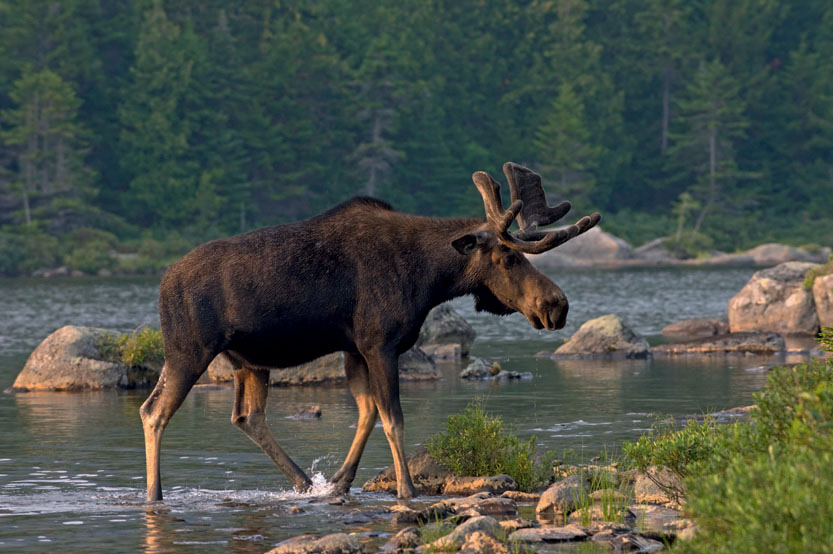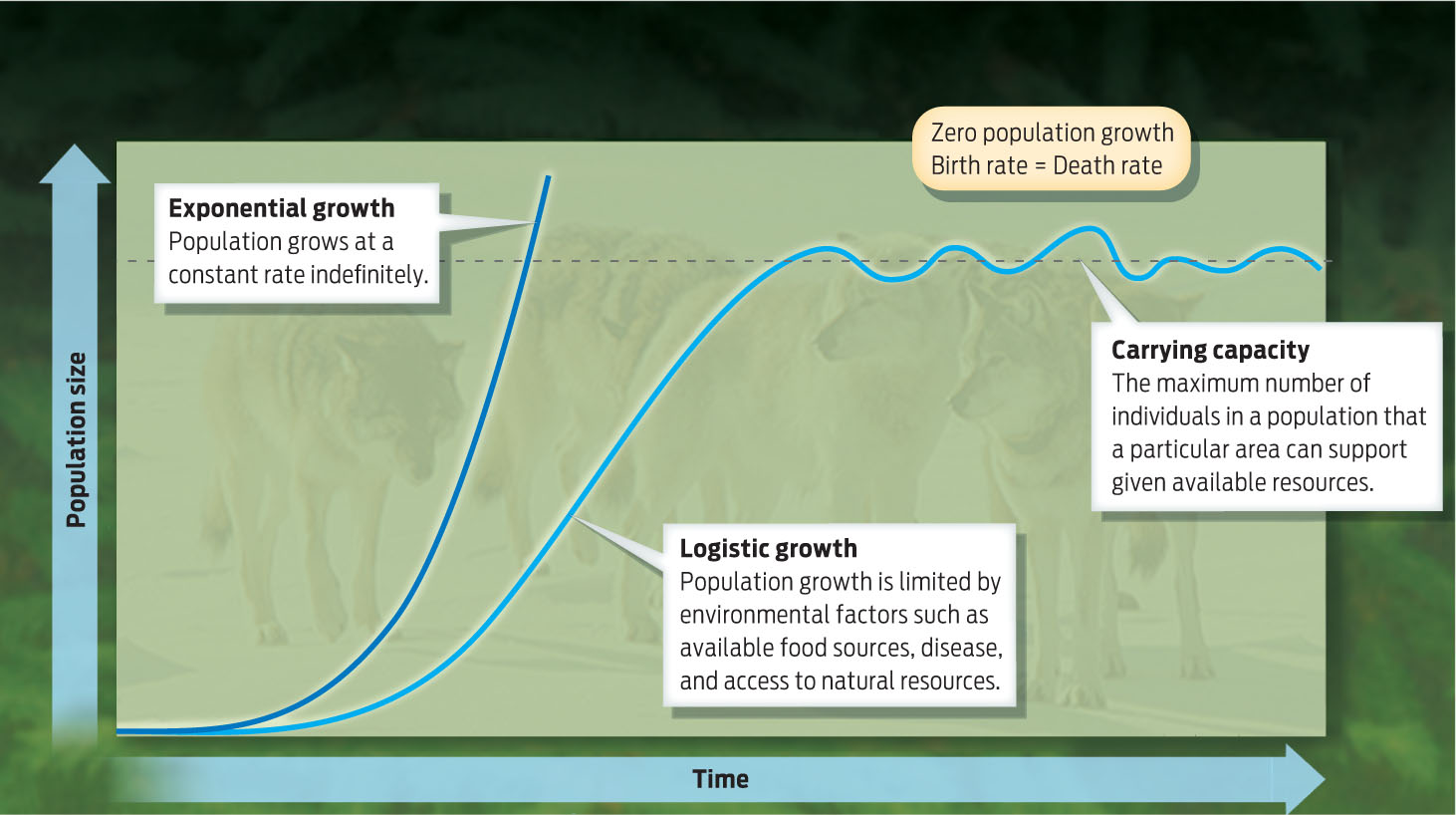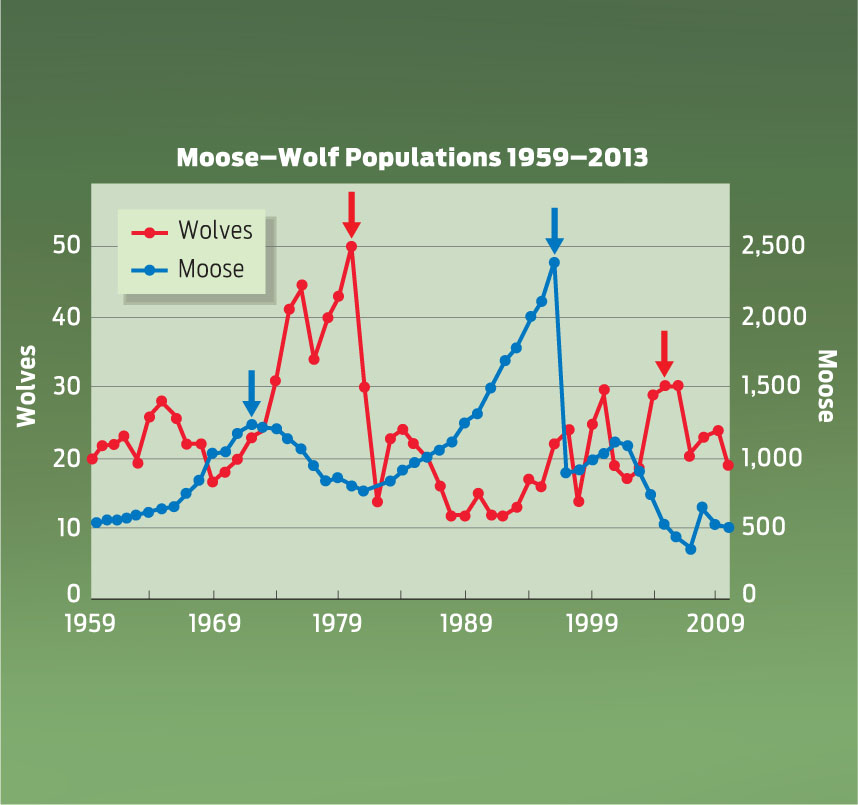POPULATION BOOM AND BUST
Moose have not always roamed Isle Royale. The first antlered settlers likely arrived around 1900, when a few especially hardy individuals swam across the 15-mile-wide channel from Canada. With an abundant food supply and no natural predators on the island, the moose population exploded, growing from a handful of individuals around the turn of the century to more than a thousand by 1920.
454

GROWTH RATE The difference between the birth rate and the death rate of a given population; also known as the rate of natural increase.
IMMIGRATION The movement of individuals into a population.
This rapid increase reflected the population’s high growth rate, defined as the birth rate minus the death rate. Because it denotes the simple balance between birth and death, the growth rate is also known as the rate of natural increase. When the birth rate of a population is greater than the death rate, the population grows; when the death rate is greater than the birth rate, the population declines; and when the two rates are equal, the result is zero population growth.
EMIGRATION The movement of individuals out of a population.
In many populations, immigration, the movement of individuals into a population, and emigration, the movement of individuals out of a population, make substantial contributions to population growth. But because the moose and wolves of Isle Royale are isolated, and individuals neither come to nor go from the island on a regular basis, their population growth rates are due only to births and deaths.
EXPONENTIAL GROWTH The unrestricted growth of a population increasing at a constant growth rate.
HABITAT The physical environment where an organism lives and to which it is adapted.
Ecologists describe two general types of population growth. The rapid and unrestricted increase of a population growing at a constant rate is called exponential growth. When a population is growing exponentially, it increases by a certain fixed percentage every generation. Thus, instead of a constant number of individuals being added at each generation—say, the population going from 100 to 120 to 140 to 160—the increase is more like credit card interest, with each increase added to the principal (the population) before the percentage is applied. And so, with an exponential growth rate of 20%, a population of 100 would increase at each generation from 100 to 120 to 144 to 173 to 207. If the population continued to grow exponentially, it would quickly get out of control, not unlike a credit card bill you don’t pay on time.
LOGISTIC GROWTH A pattern of growth that starts off fast and then levels off as the population reaches the carrying capacity of the environment.
Such unrestricted growth is rarely if ever found unchecked in nature. As populations increase, various environmental factors such as food availability and access to habitat, the physical environment where an organism lives and to which it is adapted, limit an organism’s ability to reproduce. When population-limiting factors slow the growth rate, the result is logistic growth, a pattern of growth that starts rapidly and then slows.
CARRYING CAPACITY The maximum population size that a given environment or habitat can support given its food supply and other natural resources.
Eventually, after a period of rapid growth, the size of the population may level off and stop growing. At this point, the population has reached the environment’s carrying capacity—the maximum number of individuals that an environment can support given its space and resources. Carrying capacity places an upper limit on the size of any population; no natural population can grow exponentially forever without eventually reaching a point at which resource scarcity and other factors limit population growth. This is true even of the human population (see Chapter 24) (INFOGRAPHIC 21.4) .
A population growing at a constant rate without checks will increase exponentially. However, for most populations found in nature, as the population reaches its carrying capacity, the growth rate slows and eventually remains at or near zero.

The size of a population may fluctuate around the environment’s carrying capacity, briefly exceeding it and then dropping back. After an initial overshoot of carrying capacity, factors like disease or food shortage will cause the population to shrink. This drop in turn may allow the environment time to recover its food supply, at which point the population may begin to grow again, briefly exceeding carrying capacity, and so on, in a cycle of “boom and bust.”
When moose first arrived on Isle Royale, their population grew exponentially. This unchecked proliferation of hungry mouths took a severe toll on the island; by 1929, the moose had munched their way through most of its vegetation. In turn, the reduction of the island’s food supply caused the moose population to crash. The moose population had exceeded the island’s carrying capacity, and by 1935, it had dwindled to a few hundred starving individuals.
455
The herd got lucky, though. The next summer, fire consumed 20% of the island, and the scorched areas provided space for new trees to grow. But as soon as the forest recovered, moose numbers again began to explode, ravaging the forests once more.
Then, around 1950, everything changed. One especially cold winter, a pair of gray wolves crossed an ice bridge connecting Canada to Isle Royale, forever altering the ecology of the island. Since then, the fates of the wolves and moose have been inextricably linked.

At the beginning of the Isle Royale study, in 1959, there were about 550 moose and 20 wolves on the island. Moose numbers climbed for about 15 years, reaching a peak of approximately 1,200 animals in 1972, and then declined rapidly, to a low of approximately 700 moose in 1980. As moose numbers fell, wolf numbers rose—from a low of 17 wolves in 1969 to a high of 50 animals in 1980. These two trends were linked: the wolves were feeding themselves well enough to increase their own population, but by hunting and killing so many moose they caused the moose death rate to exceed the birth rate. With a negative growth rate, the moose population shrank.
456
What would happen next? Would the wolf predators simply drive their moose prey to extinction? No one knew. The only thing to do was watch and wait. Eventually, it became clear that the two populations were rising and falling together in a specific pattern, with the size of the wolf population peaking several years after the size of the moose herd and then dropping.
Why does the wolf population fall? Because even for wolves, there’s no such thing as a free lunch: they pay a price for predation in the form of a declining food supply. The result is a repeating cycle in the numbers of predator and prey. Rather than growing exponentially and leveling off, the populations cycle through repeated rounds of boom and bust (INFOGRAPHIC 21.5) .
The wolf and moose populations are intimately linked. The wolf population peaks (red arrows) about 10 years after a peak in the moose population (blue arrows), and then declines, following the decline in the moose.
Isle Royale National Park, 1959–2013. Moose population estimates for 1959–2001 are based on population reconstruction from recoveries of dead moose. Estimates for 2002 to 2013 are based on aerial surveys.
